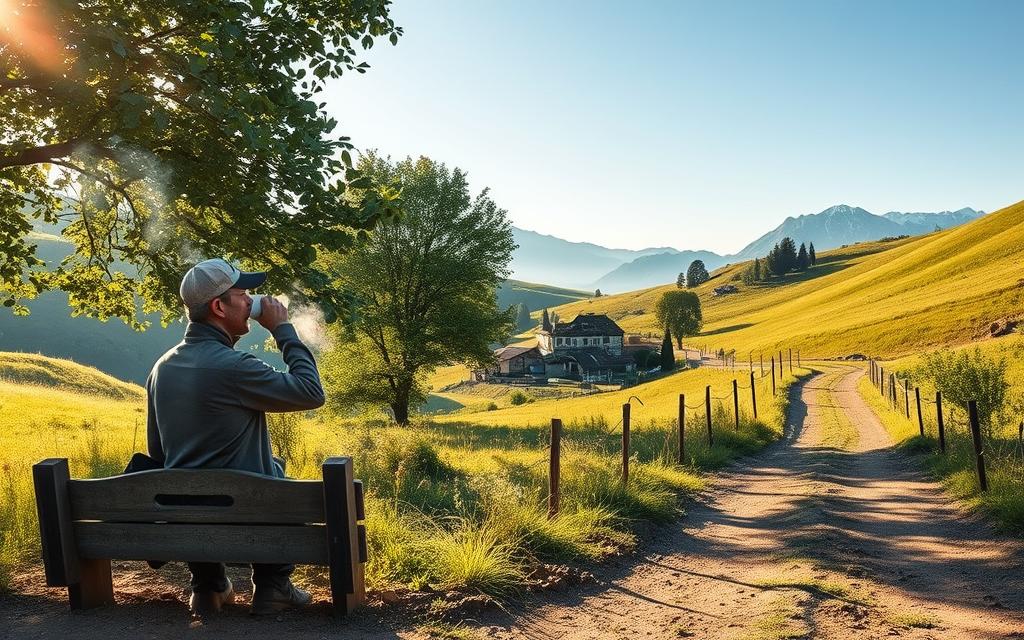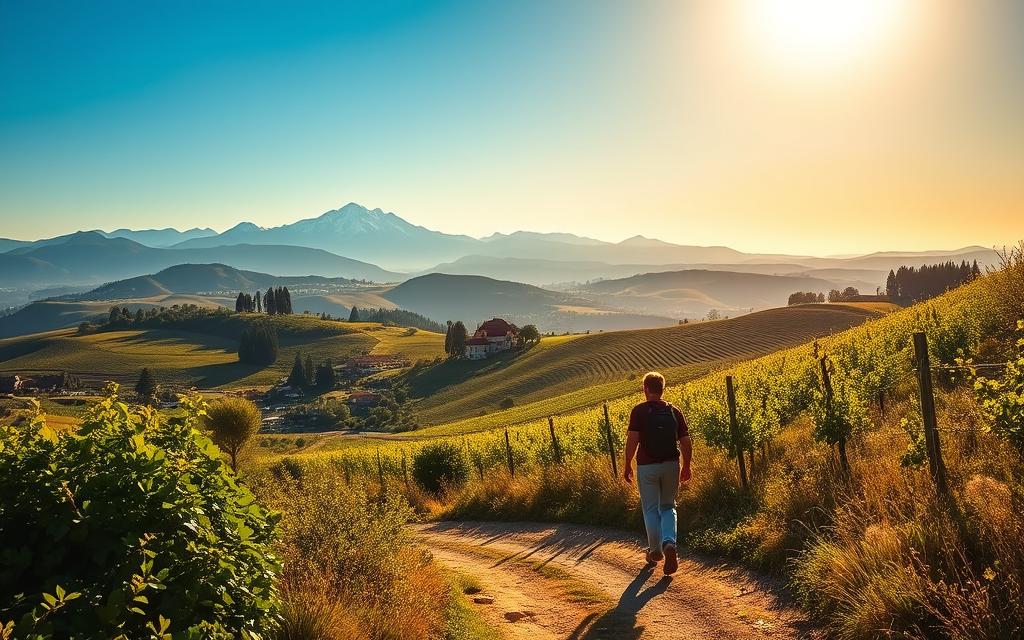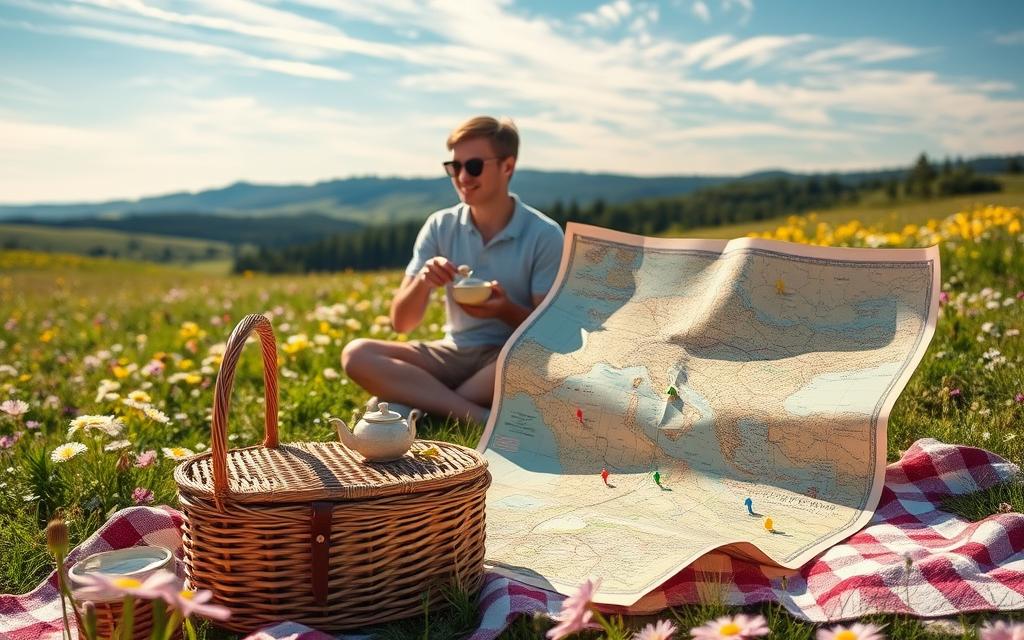As summer approaches, many of us look forward to taking a break from our daily routines and exploring new destinations. Embracing slow travel can transform your summer vacation into a truly unforgettable experience.
Traveling leisurely allows you to immerse yourself in the local culture, savoring every moment of your journey. By adopting a mindful vacation approach, you can create lasting memories and enjoy a more relaxed pace.
An immersive travel experience is about connecting with the places you visit on a deeper level. It’s an invitation to explore beyond the usual tourist trails and engage with the local community, making your summer vacation truly special.
Understanding the Philosophy of Slow Travel
As travelers, embracing the philosophy of slow travel can lead to a more fulfilling experience. Slow travel is not just about reaching a destination; it’s about immersing oneself in the journey, savoring the moments, and connecting with the local culture.
The Origins and Evolution of Slow Travel
The concept of slow travel has its roots in the slow food movement, which emerged as a response to fast food culture. It emphasizes the importance of taking time to enjoy local cuisine and culture. Over time, this philosophy has evolved to encompass travel, encouraging a more mindful and present approach to exploring new destinations.

How Slow Travel Differs from Traditional Tourism
Unlike traditional tourism, which often involves rushing from one attraction to another, slow travel is about adopting a more relaxed pace. It’s about quality over quantity, focusing on a few meaningful experiences rather than trying to see everything. This approach allows travelers to truly absorb the essence of a place.
Benefits for Mental and Emotional Wellbeing
Slow travel offers numerous benefits for mental and emotional wellbeing. By reducing the stress associated with rushed travel itineraries, individuals can enjoy a more peaceful and rejuvenating experience. Moreover, the deeper connections made with local cultures and communities can enhance feelings of happiness and fulfillment.
| Aspect | Slow Travel | Traditional Tourism |
|---|---|---|
| Pace | Relaxed, flexible | Fast, scheduled |
| Focus | Quality experiences | Seeing many attractions |
| Connection with locals | Deep, meaningful | Superficial |
The Art of Slow Travel: Savoring Your Summer Vacation
As summer approaches, embracing the art of slow travel can transform your vacation into a meaningful experience. It’s about adopting a mindset that values depth over breadth, allowing you to truly savor your summer vacation.

Mindfulness and Presence in Travel Experiences
Mindfulness is at the heart of slow travel. By being fully present in your travel experiences, you can appreciate the small details that often go unnoticed. This mindfulness allows for a deeper connection with the places you visit and the people you meet, enriching your journey.
Quality Over Quantity: Depth vs. Breadth
Slow travel emphasizes quality over quantity, encouraging travelers to explore fewer destinations with greater depth. This approach not only enhances your understanding of a place but also fosters a more meaningful connection with the local culture and environment.
Creating Meaningful Memories Through Intentional Experiences
By focusing on intentional travel experiences, you can create meaningful memories that last a lifetime. Whether it’s through engaging with local communities, participating in cultural events, or simply enjoying the natural beauty around you, slow travel helps you craft a more fulfilling travel narrative.
In essence, the art of slow travel is about embracing a journey that is as enriching as the destination itself. By incorporating mindfulness, prioritizing quality, and seeking intentional experiences, you can truly savor your summer vacation and return home with a renewed sense of purpose and joy.
Planning Your Slow Travel Summer Experience
Planning a slow travel summer vacation requires a thoughtful approach to create meaningful experiences. It’s about more than just choosing a destination; it’s about crafting a journey that nourishes both body and soul.
Setting Intentions for Your Journey
Before you start making travel plans, take time to reflect on what you hope to achieve or experience during your slow travel summer. Are you looking to relax, explore new cultures, or perhaps challenge yourself? Setting clear intentions will help guide your decisions and ensure your trip aligns with your personal goals.
Creating a Flexible Itinerary
A flexible itinerary is crucial for slow travel. It allows you to embrace unexpected opportunities while still having a general direction. When planning, consider leaving some space for spontaneity.
Balancing Structure and Spontaneity
Finding the right balance between having a plan and being open to new experiences is key. Too much structure can make your trip feel rigid, while too much spontaneity might leave you feeling lost.

Budgeting Time Rather Than Just Money
In slow travel, time is a more valuable currency than money. Budgeting your time effectively means prioritizing experiences over mere sightseeing. Consider allocating more time to fewer activities to truly immerse yourself.
Building in Downtime and Reflection
Downtime is essential for reflection and rejuvenation. Make sure to include periods of rest in your itinerary, allowing you to absorb the experiences you’ve had and reflect on your journey.
By thoughtfully planning your slow travel summer experience, you can create a journey that is both fulfilling and memorable.
Choosing Destinations That Support Slow Travel
The essence of slow travel lies in selecting destinations that foster a deeper connection with the local culture and environment. When travelers choose places that align with the principles of slow travel, they are more likely to have meaningful and enriching experiences.
Lesser-Known Locations Worth Exploring
Venturing off the beaten path can lead to discovering hidden gems that are rich in character and authenticity. Places like Annecy, France, with its cobblestone streets and stunning mountain views, or Colonia del Sacramento, Uruguay, known for its charming Portuguese architecture, offer unique slow travel experiences. These destinations are not only beautiful but also less crowded, allowing for a more relaxed pace.
Destinations with Strong Local Culture
Destinations that have a strong, vibrant local culture are ideal for slow travel. Places like Kyoto, Japan, with its traditional tea ceremonies and festivals, or Tuscany, Italy, known for its wine and local cuisine, provide numerous opportunities to engage with local customs and communities. Immersing oneself in these cultures can be a profoundly enriching experience.
Considering Transportation and Accessibility
When choosing a slow travel destination, it’s also important to consider how to get there and how to move around. Places with accessible public transportation or those that are easily walkable or bikeable are preferable. For instance, cities like Copenhagen, Denmark, with its extensive cycling infrastructure, or Portland, Oregon, known for its public transit and walkability, make it easy to explore without relying on cars.
| Destination | Key Features | Accessibility |
|---|---|---|
| Annecy, France | Mountain views, cobblestone streets | Walkable, nearby airports |
| Colonia del Sacramento, Uruguay | Portuguese architecture, river views | Accessible by ferry, walkable |
| Kyoto, Japan | Traditional tea ceremonies, festivals | Public transportation, walkable |
Immersive Activities for the Slow Traveler
Immersive activities are the heart of slow travel, allowing you to connect with the essence of a destination. These activities not only enhance your travel experience but also foster a deeper understanding and appreciation of the local culture and environment.
Connecting with Local Communities
One of the most rewarding aspects of slow travel is connecting with local communities. This can be achieved by staying in locally-owned accommodations, participating in community events, or simply engaging in conversations with the locals. Homestays and community-based tourism initiatives offer a unique opportunity to experience the daily life and traditions of the local people.
Culinary Exploration and Food Experiences
Food is a universal language, and culinary exploration is a vital part of the slow travel experience. Savoring local cuisine and drinks not only delights the palate but also provides insight into the local culture and history. Consider taking a cooking class or visiting local markets to immerse yourself in the culinary traditions of the region.
Nature-Based Slow Travel Activities
Nature-based activities are another crucial aspect of slow travel. Engaging in outdoor activities such as hiking, kayaking, or wildlife watching allows travelers to connect with the natural environment and enjoy the beauty of the destination. These activities promote a sense of well-being and encourage a slower, more mindful pace.
Digital Disconnection and Mindful Technology Use
In today’s digital age, it’s easy to get caught up in the constant stream of information. Slow travel encourages digital disconnection and mindful technology use. By setting aside time to disconnect from devices, travelers can focus on the present moment and fully immerse themselves in the travel experience.
By incorporating these immersive activities into your slow travel experience, you can create meaningful memories and develop a deeper appreciation for the destination.
Sustainable Practices in Slow Travel
The slow travel ethos is deeply intertwined with sustainable practices, promoting a more responsible form of tourism. As travelers embrace the slow travel philosophy, they inherently adopt practices that minimize their impact on the environment and local communities.
Environmental Considerations
Slow travelers prioritize environmental sustainability by choosing eco-friendly accommodations, reducing waste, and conserving resources. This mindful approach to travel helps preserve the natural beauty of destinations for future generations.
Supporting Local Economies
By engaging with local businesses and communities, slow travelers contribute to the local economy. This support helps maintain the unique character of destinations and fosters community development.
Ethical Travel Choices
Making ethical travel choices involves respecting local cultures, traditions, and wildlife. Slow travelers are encouraged to be mindful of their actions and their impact on the places they visit.
Reducing Your Travel Footprint
Reducing one’s travel footprint is a key aspect of sustainable slow travel. This can be achieved by using public transportation, minimizing air travel, and offsetting carbon emissions when necessary.
| Sustainable Practice | Impact | Action |
|---|---|---|
| Choosing Eco-Friendly Accommodations | Reduces environmental impact | Research and select hotels or lodges with sustainable practices |
| Supporting Local Businesses | Boosts local economy | Dine at local restaurants, shop at local markets |
| Minimizing Waste | Decreases pollution | Use reusable bags, water bottles, and avoid single-use plastics |
Bringing the Slow Travel Mindset Home
As you settle back into your daily routine, it’s essential to hold onto the slow travel mindset you’ve cultivated during your summer vacation. Maintaining mindfulness is key to integrating the lessons and memories from your travels into your everyday life.
Take time for travel reflection, journaling about your experiences, and the people you met along the way. This will help you process the emotions and insights gained during your journey, allowing you to bring the slow travel mindset home.
By incorporating mindfulness practices, such as meditation or deep breathing, you can continue to nurture the sense of calm and presence you developed while traveling. This will enable you to approach daily challenges with a clearer mind and a more positive outlook.
As you reflect on your travels, consider how you can apply the principles of slow travel to your daily life, such as being more present in your interactions and appreciating the small joys around you. By doing so, you’ll be able to sustain the benefits of slow travel long after your trip has ended.







